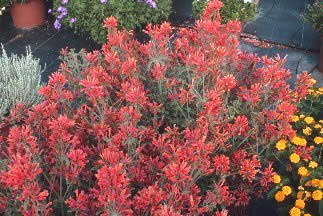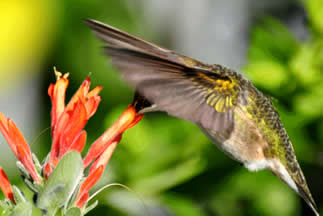Hummingbird Plant - Dicliptera suberecta |
|
|
Acanthaceae Dicliptera Suberecta None |
|
| Price |
|
| Availability and Options |
Temporarily Out Of Stock This product is temporarily out of stock. Restocks typically occur at the beginning of each week. Check back soon and sorry for the inconvenience! Other Options: |
| Shipping Information | |
| Grows In | Zone 7A · 0° to 5° F through Zone 10B · 35° to 40° F |
| Sun Exposure | Full / Mostly Sun, Morning Sun / Evening Shade |
| Soil Drainage | Well Drained |
| Resistent To | Deer Resistant, Drought, Insect, Disease, Heat |
| Blooms | Spring Blooms, Summer Blooms, Fall Blooms |
| Foliage Color | Grey / Silver |
| Average Height | 1' to 2' |
| Average Width | 2' to 3' |
| Attracts | Butterflies, Hummingbirds, Visual Attention |
| Fragrances | None |
 More About The Hummingbird Plant...
More About The Hummingbird Plant...Hummingbird Plant, Dicliptera suberecta, is one of the few perennials from Uruguay that we stock...makes you wonder what else might be there. This heat and drought tolerant perennial plant produces numerous clusters of electric orange, upright facing, tubular flowers throughout the warm season that the hummingbirds will flock to and appreciate! Equally attractive in the garden are the felty, silver-grey leaves that cover the 2 foot tall by 3 foot wide mound.
The felty silver-grey foliage of the Hummingbird Plant is a wonderful contrast in any sunny to partially shaded garden and is a must in your hummingbird garden! It also works well singly or in combination with other plants in container gardens. It combines wonderfully in the garden or in a large container with Black & Blue Salvia, another top hummingbird attracting plant.
 The Hummingbird Plant is very easy to grow. We've successfully grown this plant in both full sun and light shade. Provide it at loeast 5 nhours of sun for best flowering. Well-drained soil is a must. Constantly soggy or wet soils can be problematic. Heavy, dense clay soils should be amended with organic matter and/or sand to improve drainage.
The Hummingbird Plant is very easy to grow. We've successfully grown this plant in both full sun and light shade. Provide it at loeast 5 nhours of sun for best flowering. Well-drained soil is a must. Constantly soggy or wet soils can be problematic. Heavy, dense clay soils should be amended with organic matter and/or sand to improve drainage.
Maintenance is easy as well. Water regularly until established but be careful not to over-water as Dicliptera does not like wet feet. Once established and for best bloom production, fertilize every 6 weeks during the warm season with a good flower food. If plant dies back during winter dead growth may be removed and a light coat of mulch applied.
So far, in our gardens here in Zone 8 of mid-Georgia, we've seen the Hummingbird Plant survive temperatures as low as 15 degrees F. Sources on the internet suggest it to be hardy in Zones 7-10. In zones 7 and 8 it may die back during colder winters to then reemerge strong in spring.
Dicliptera suberecta is a hummingbird's dream come true...If attracting hummingbirds is one of your goals this plant is a must for your garden!